By THERESA HITCHENS
 Chinese forces erect ballistic missiles at night. China’s SC-19 ASAT is believed to be derived from the DF-21C ballistic missile.
Chinese forces erect ballistic missiles at night. China’s SC-19 ASAT is believed to be derived from the DF-21C ballistic missile.
WASHINGTON: The US must find a balance between countering China’s antisatellite (ASAT) weapons efforts and cooperating with it to stave off broader risks to the space operational environment, says a new Brookings Institution report.
“The United States faces a fundamental dilemma as it attempts to effectively manage China’s rise as a major actor in outer space,” says author Frank Rose, State Department assistant secretary for arms control under President Barak Obama. “On one hand, China’s development of anti-satellite weapons represents a direct threat to U.S. and allied space systems. On the other hand, it is difficult to see how the United States and the international community will be able to address the key challenges facing the outer space environment — i.e., the growth of orbital debris and the rise of mega constellations — without engaging with China.”
Managing China’s Rise In Outer Space says the US must live with the fact that China will be a peer in space, both militarily and in the civil and commercial spheres. For example, the report points out that China is second only to the US in the number of military and commercial remote sensing satellites it operates.
While the US needs to deter China’s growing ASAT capabilities, it also must boost languishing diplomatic relations with Beijing on space issues that are, by necessity and physics, of mutual concern.
“Enhancing deterrence and increasing resiliency against Chinese ASAT threats;
Reinvigorating the U.S.-China bilateral dialogue on space security issues;
Continuing the U.S.-China Civil Space Dialogue;
Developing bilateral and multilateral norms of behavior for outer space;
Identifying ways to cooperate with China on pragmatic civil space projects; and,
Reviewing current congressional limitations on civil space cooperation with China.”
Rose notes that, while the Trump administration has taken efforts to counter Chinese ASAT capabilities, it has also allowed diplomatic efforts to languish.
“After a robust period of dialogue during the Obama administration, the bilateral U.S.-China dialogue on space security has been largely neglected in the Trump administration,” the paper says.
The Trump White House is trying to woo China on one aspect of future space endeavors: resource extraction. As I reported early last month, the White House sees Beijing as a potential ally in its efforts to establish the somewhat controversial legal status of commercial mining of the Moon and asteroids.
Rose documents China’s growing space presence, noting that “China currently operates over 120 intelligence, surveillance and reconnaissance (ISR) and remote sensing satellites, second only to the United States.”
Beijing isn’t satisfied with the status quo so it continues to improve those capabilities, “as demonstrated by the July 2018 launch of the Gaofen-11, its highest resolution imagery satellite to date. Since then, China has launched 14 Gaofen satellites into orbit.,” the study notes.
China also “operates approximately 34 communication satellites, of which about four are dedicated exclusively for military uses,” Rose’s study states, while also expanding its BeiDou precision, navigation, and timing (PNT) system that, similar to the US GPS system, will this year reach its goal of global coverage.
The expansion of the BeiDou will “likely improve its ability to target precision-guided munitions, and lessen China’s dependence on GPS, which the Chinese government fears the United States might deny access to during a crisis,” the Brookings report stresses.
China’s ASAT ambitions have been well documented, most recently by two studies on global counterspace developments — authored respectively by the Center for Strategic and International Studies (CSIS) and Secure World Foundation (SWF). The studies, released at the end of March, found substantial open-source evidence of a variety of Chinese efforts to develop counterspace-related technology — from radio-frequency jamming to lasers for blinding satellites to ground-based missiles to on-orbit ‘killer satellite’ techniques.
The studies differ slightly on the level of the threat constituted by those efforts, however, based on the state of technological progress.
SWF’s “Global Counterspace Capabilities” was the more cautious of the two, saying that that China’s ability to destroy satellites in Low Earth Orbit (LEO, up to 2,000 kilometers in altitude where most observation satellites operate) “is likely mature and likely operationally fielded on mobile launchers.” The premier ASAT weapon thought to be in the PLA’s arsenal is the SC-19, which experts believe is modeled on the DF-21C ballistic missile with a range of between 2,150 and 2,500 kilometers, SWF said.
CSIS, in “Space Threat Assessment 2020,” sounds a much bigger alarm. China already “has started training” specialize units of the Strategic Space Force (SSF) using direct-ascent kinetic ASATs capable of destroying satellites, CSIS warns.
No comments:
Post a Comment